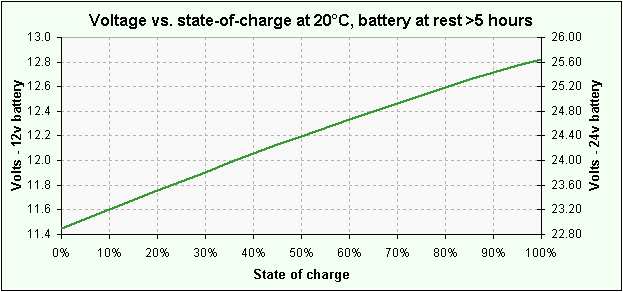


Battery Discharge Protection -
12V Batteries have a very small voltage tolerance or working range.
This is typically only about 1 volt, this goes from a fully charged battery at 12.8V down to a fully discharged battery at around 11.5V. (See the graph below)
Ideally we do not want to discharge batteries below 12V which is where they start to be permanently damaged by sulphation (hardening) of the plates.
The other problem with discharging a battery below 12V is that most engines will need at least this voltage to start. Battery discharge protectors generally shut off the load or current drain at 11.8V which will give the battery a chance to recover to just over 12V being enough to start the engine. This is especially important if you do not have an auxillary battery system fitted to the vehicle.
Most people manage their battery systems very well and have volt meters or some form of battery monitor to closely watch battery voltage and recharge when required. This battery management comes from their personal experiences with flat batteries, battery failure, fridge problems and general short life span of batteries caused by deep discharge and poor battery management.
Batteries have a limited number of cycles and the deeper the discharge the fewer cycles you will get from a battery. For example an AGM battery will return 250 cycles down to 11.5V but this jumps to 1200 cycles at a discharge 30% or 12.4V. (It is also important to try fully charge the battery on every cycle)
So why battery discharge protection at 11.8V ?
This is a fail safe voltage and is used by many manufacturers of fridges, inverters and DC chargers, if any of these accessories are working at a voltage lower than they are designed for it causes stress on electronic components and control devices such as output voltage, compressor speeds and monitoring.
11.8V shut off will also prevent many people from deep discharging batteries and reducing their cycle life which in turn affects the environment.
Notes: 11.8V shut off is typically the voltage seen minutes after the ODP switches off. With load connected most ODP devices may switch off at 11.0V to 11.5V with a load such as a fridge or LCD TV connected. Batteries must be in good condition to recover to 12V+ and some older batteries may not have the reserve capacity to do this. It is good practice to have your batteries tested at least twice a year and to keep them maintained with a suitable battery charger. We have used 11.8V as a guide and this is not a industry standard voltage cut off set point.




